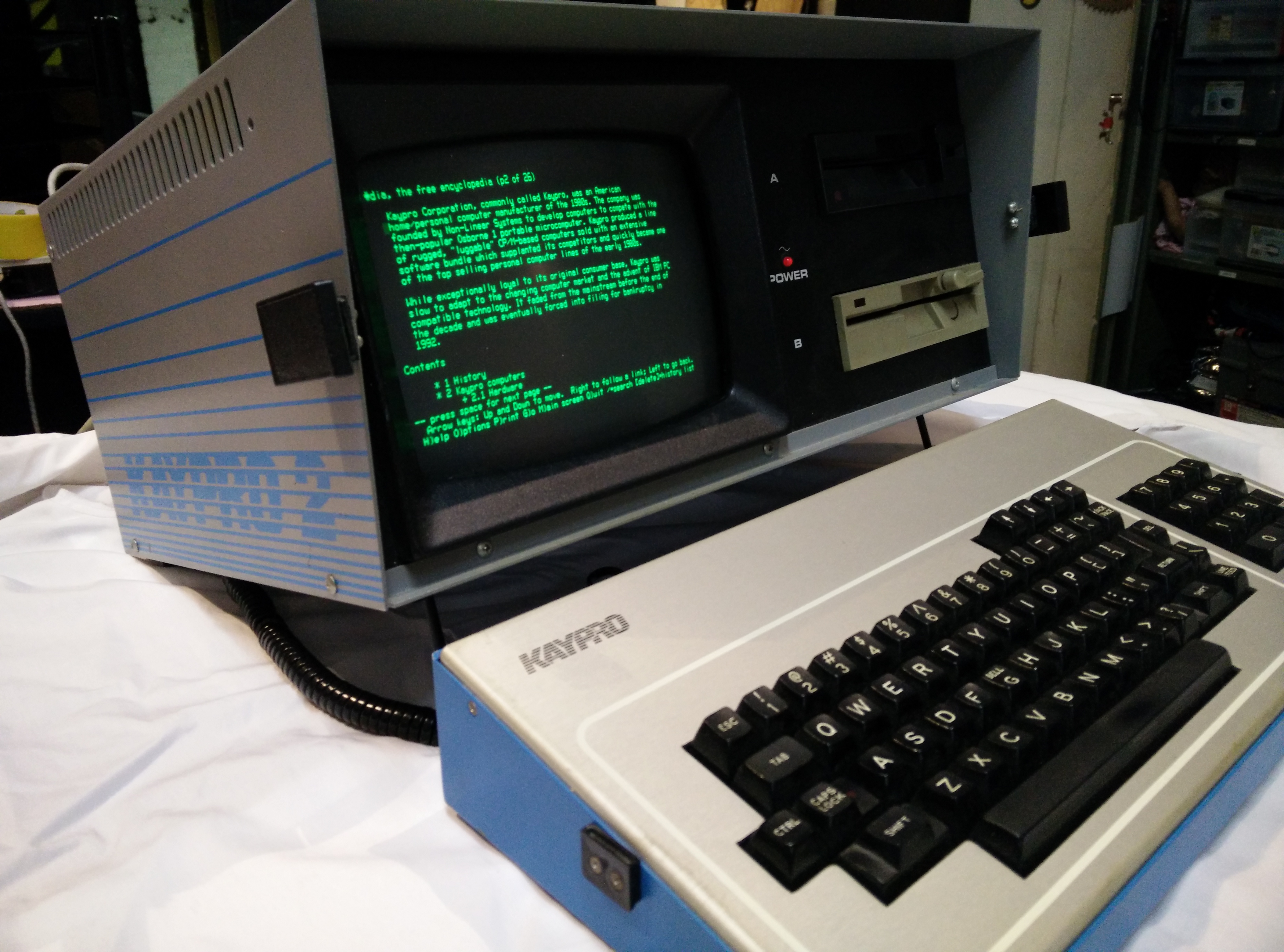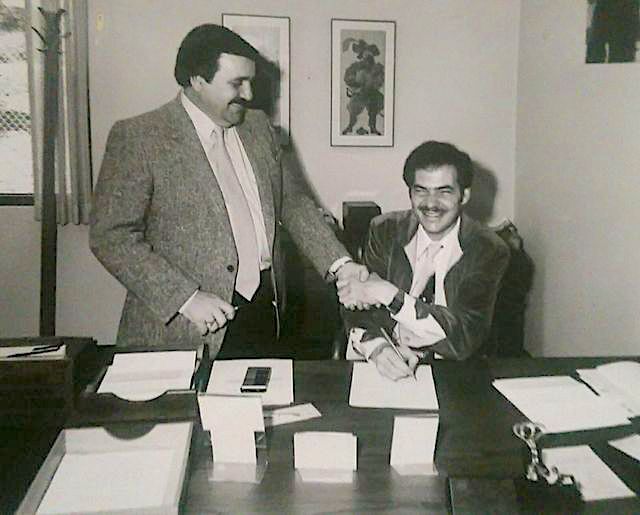|
Kaypro
Kaypro Corporation was an American home and personal computer manufacturer based out of San Diego in the 1980s. The company was founded by Non-Linear Systems (NLS) to compete with the popular Osborne 1 portable microcomputer. Kaypro produced a line of rugged, "luggable" CP/M-based computers sold with an extensive software bundle which supplanted its competitors and quickly became one of the top-selling personal computer lines of the early 1980s. Kaypro was exceptionally loyal to its original customer base but slow to adapt to the changing computer market and the advent of IBM PC compatible technology. It faded from the mainstream before the end of the decade and was eventually forced into bankruptcy in 1992. History Kaypro began as Non-Linear Systems, a maker of electronic test equipment, founded in 1952 by Andrew Kay, the inventor of the digital voltmeter. In the 1970s, NLS was an early adopter of microprocessor technology, which enhanced the flexibility of products such as ... [...More Info...] [...Related Items...] OR: [Wikipedia] [Google] [Baidu] |
Kaypro In Israel 1984
Kaypro Corporation was an American home and personal computer manufacturer based out of San Diego in the 1980s. The company was founded by Non-Linear Systems (NLS) to compete with the popular Osborne 1 portable microcomputer. Kaypro produced a line of rugged, "luggable" CP/M-based computers sold with an extensive software bundle which supplanted its competitors and quickly became one of the top-selling personal computer lines of the early 1980s. Kaypro was exceptionally loyal to its original customer base but slow to adapt to the changing computer market and the advent of IBM PC compatible technology. It faded from the mainstream before the end of the decade and was eventually forced into bankruptcy in 1992. History Kaypro began as Non-Linear Systems, a maker of electronic test equipment, founded in 1952 by Andrew Kay, the inventor of the digital voltmeter. In the 1970s, NLS was an early adopter of microprocessor technology, which enhanced the flexibility of products such as ... [...More Info...] [...Related Items...] OR: [Wikipedia] [Google] [Baidu] |
CP/M
CP/M, originally standing for Control Program/Monitor and later Control Program for Microcomputers, is a mass-market operating system created in 1974 for Intel 8080/ 85-based microcomputers by Gary Kildall of Digital Research, Inc. Initially confined to single-tasking on 8-bit processors and no more than 64 kilobytes of memory, later versions of CP/M added multi-user variations and were migrated to 16-bit processors. The combination of CP/M and S-100 bus computers became an early standard in the microcomputer industry. This computer platform was widely used in business through the late 1970s and into the mid-1980s. CP/M increased the market size for both hardware and software by greatly reducing the amount of programming required to install an application on a new manufacturer's computer. An important driver of software innovation was the advent of (comparatively) low-cost microcomputers running CP/M, as independent programmers and hackers bought them and shared their crea ... [...More Info...] [...Related Items...] OR: [Wikipedia] [Google] [Baidu] |
Osborne 1
The Osborne 1 is the first commercially successful portable computer, released on April 3, 1981 by Osborne Computer Corporation. It weighs , cost US$1,795, and runs the CP/M 2.2 operating system. It is powered from a wall socket, as it has no on-board battery, but it is still classed as a portable device since it can be hand-carried when the keyboard is closed. The computer shipped with a large bundle of software that was almost equivalent in value to the machine itself, a practice adopted by other CP/M computer vendors. Competitors quickly appeared, such as the Kaypro II. History The Osborne 1 was developed by Adam Osborne and designed by Lee Felsenstein, first announced in early 1981. Osborne, an author of computer books decided that he wanted to break the price of computers. The computer's design was based largely on the Xerox NoteTaker, a prototype developed at Xerox PARC in 1976 by Alan Kay. It was designed to be portable, with a rugged ABS plastic case and a handle. The Os ... [...More Info...] [...Related Items...] OR: [Wikipedia] [Google] [Baidu] |
Osborne Computer Corporation
The Osborne Computer Corporation (OCC) was a pioneering maker of portable computers. It was located in the Silicon Valley of the southern San Francisco Bay Area in California. The Henry Ford Blog: "The Rise and Fall of the Osborne Computer Corporation" April 16, 2015 — with images. Adam Osborne, the founder of the company, developed, with design work from , the world's first mass-produced portable computer in 1981. History Osborne 1 [...More Info...] [...Related Items...] OR: [Wikipedia] [Google] [Baidu] |
Andrew Kay
Andrew F. Kay (January 22, 1919 – August 28, 2014) was a businessman and innovator. He was President and CEO of Kaypro, a personal computer company, which at one time was the world's fourth largest manufacturer of computers, and the largest in the world in sales of portable computers. Kay, a 1940 graduate of MIT, started his career with Bendix followed by two years at Jet Propulsion Laboratory. In 1952, Kay founded Non-Linear Systems, a manufacturer of digital instrumentation. NLS developed a reputation for providing rugged durability in critical applications for everything from submarines to spacecraft. At NLS he invented the digital voltmeter, in 1954. Kaypro began selling computers in the early 1980s. In 1985, it had more than $120 million in revenues, dwarfing what had been its parent, NLS. But the company's success was relatively short-lived; in 1990 it filed for Chapter 11 bankruptcy protection, and it was liquidated in 1992. In the late 1990s, Kay founded Kay Comput ... [...More Info...] [...Related Items...] OR: [Wikipedia] [Google] [Baidu] |
Bundled Software
In marketing, product bundling is offering several products or services for sale as one combined product or service package. It is a common feature in many imperfectly competitive product and service markets. Industries engaged in the practice include telecommunications services, financial services, health care, information, and consumer electronics. A software bundle might include a word processor, spreadsheet, and presentation program into a single office suite. The cable television industry often bundles many TV and movie channels into a single tier or package. The fast food industry combines separate food items into a "meal deal" or "value meal". A bundle of products may be called a package deal, in recorded music or video games, a compilation or box set, or in publishing, an anthology. Most firms are multi-product or multi-service companies faced with the decision whether to sell products or services separately at individual prices or whether combinations of products sh ... [...More Info...] [...Related Items...] OR: [Wikipedia] [Google] [Baidu] |
Non-Linear Systems
Non-Linear Systems is an electronics manufacturing company based in San Diego, California. Non-Linear Systems was founded in 1952, by Andrew Kay, the inventor of the digital voltmeter in 1954. By John Gantz, InfoWorld, 20 Aug 1984, Page 20 NLS developed a reputation for providing rugged durability in critical applications for everything from submarines to spacecraft. Later the company developed miniature digital voltmeters and s. During the early 1980s the company started |
Micro Cornucopia
''Micro Cornucopia'', sometimes shortened to ''Micro C'', was a 1980s magazine for microcomputer hobbyists and enthusiasts. It was published in Bend, Oregon by former Tektronix engineer David J. Thompson. The magazine, originally conceived as a newsletter for users of the Ferguson Big Board (a single-board CP/M computer), was published bi-monthly beginning in July 1981. It soon expanded its coverage to other board-level computers, the Kaypro computer, and general hobbyist/experimental computing, with special interest areas being robotics, interfacing, embedded systems and programming languages. The magazine routinely published circuit diagrams and source code. ''Micro C'' carried articles on a wide range of subjects, some system-specific and newsletter-like, but also covering (then) off-mainstream topics, e.g. 3D graphics, artificial intelligence, or the special needs of disabled users. They published a 32-page catalog of CP/M and MS-DOS software, cover date Fall/Winter 198 ... [...More Info...] [...Related Items...] OR: [Wikipedia] [Google] [Baidu] |
Zilog Z80
The Z80 is an 8-bit microprocessor introduced by Zilog as the startup company's first product. The Z80 was conceived by Federico Faggin in late 1974 and developed by him and his 11 employees starting in early 1975. The first working samples were delivered in March 1976, and it was officially introduced on the market in July 1976. With the revenue from the Z80, the company built its own chip factories and grew to over a thousand employees over the following two years. The Zilog Z80 is a software-compatible extension and enhancement of the Intel 8080 and, like it, was mainly aimed at embedded systems. Although used in that role, the Z80 also became one of the most widely used CPUs in desktop computers and home computers from the 1970s to the mid-1980s. It was also common in military applications, musical equipment such as synthesizers (like the Roland Jupiter-8), and coin-operated arcade games of the late 1970s and early 1980s, including '' Pac-Man''. Zilog licensed the ... [...More Info...] [...Related Items...] OR: [Wikipedia] [Google] [Baidu] |
Voltmeter
A voltmeter is an instrument used for measuring electric potential difference between two points in an electric circuit. It is connected in parallel. It usually has a high resistance so that it takes negligible current from the circuit. Analog voltmeters move a pointer across a scale in proportion to the voltage measured and can be built from a galvanometer and series resistor. Meters using amplifiers can measure tiny voltages of microvolts or less. Digital voltmeters give a numerical display of voltage by use of an analog-to-digital converter. Voltmeters are made in a wide range of styles, some separately powered (e.g. by battery), and others powered by the measured voltage source itself. Instruments permanently mounted in a panel are used to monitor generators or other fixed apparatus. Portable instruments, usually equipped to also measure current and resistance in the form of a multimeter, are standard test instruments used in electrical and electronics work. Any measurem ... [...More Info...] [...Related Items...] OR: [Wikipedia] [Google] [Baidu] |
Bend, Oregon
Bend is a city in and the county seat of Deschutes County, Oregon, United States. It is the principal city of the Bend Metropolitan Statistical Area. Bend is Central Oregon's largest city, with a population of 99,178 at the time of the 2020 U.S. Census, up from 76,693 at the time of the 2010 U.S. Census, and 52,029 at the 2000 United States Census, 2000 census. The Bend, OR MSA, Bend metro population was 198,253 as of the 2020 census. It is the fifth largest metropolitan area in Oregon. Bend is located on the eastern edge of the Cascade Range along the Deschutes River (Oregon), Deschutes River. There the Pinus ponderosa, Ponderosa pine forest transitions into the High Desert (Oregon), high desert, characterized by arid land, junipers, sagebrush, and Purshia, bitterbrush. Originally a crossing point on the river, settlement began in the early 1900s. Bend was incorporated as a city in 1905. Economically, it started as a logging town but is now identified as a gateway for many outd ... [...More Info...] [...Related Items...] OR: [Wikipedia] [Google] [Baidu] |





